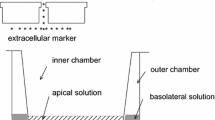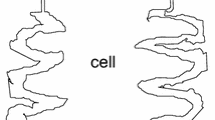Abstract
Layers of rabbit corneal endothelial cells were cultured on permeable inserts. We characterized the diffusional permeability of the cell layer to nonelectrolyte and charged molecules and compared the diffusional and filtration permeabilities of the paracellular and transcellular pathways. We determined the rates of diffusion of 3H- and 14C-labeled nonelectrolyte test molecules and estimated the equivalent pore radius of the tight junction. Negatively charged molecules permeate slower than neutral molecules, while positively charged molecules permeate faster. Palmitoyl-dl-carnitine, which opens tight junctions, caused an increase of permeability and equivalent pore radius. Diffusional water permeability was determined with 3H-labeled water; the permeabilities of the tight junction and lateral intercellular space were calculated using tissue geometry and the Renkin equation. The diffusional permeability (P d ) of the paracellular pathway to water is 0.57 μm s−1 and that of the transcellular path is 2.52 μm s−1. From the P d data we calculated the filtration permeabilities (P f ) for the paracellular and transcellular pathways as 41.3 and 30.2 μm s−1, respectively. In conclusion, the movement of hydrophilic molecules through tight junctions corresponds to diffusion through negatively charged pores (r = 2.1 ± 0.35 nm). The paracellular water permeability represents 58% of the filtration permeability of the layer, which points to that route as the site of sizable water transport. In addition, we calculated for NaCl a reflection coefficient of 0.16 ≤ σNaCl ≤ 0.33, which militates against osmosis through the junctions and, hence, indirectly supports the electro-osmosis hypothesis.









Similar content being viewed by others
References
Beck RE, Schultz JS (1970) Hindered diffusion in microporous membranes with known pore geometry. Science 170:1302–1305
Diecke FP, Ma L, Iserovich P, Fischbarg J (2007) Corneal endothelium transports fluid in the absence of net solute transport. Biochim Biophys Acta 1768:2043–2048
Donn A, Miller SL, Mallett NM (1963) Water permeability of the living cornea. Arch Ophthalmol 70:515–521
Durbin RP (1960) Osmotic flow of water across permeable cellulose membranes. J Gen Physiol 44:315–326
Echevarria M, Kuang K, Iserovich P, Li J, Preston GM, Agre P, Fischbarg J (1993) Cultured bovine corneal endothelial cells express CHIP28 water channels. Am J Physiol Cell Physiol 265:C1349–C1355
Fischbarg J (2010) Fluid transport across leaky epithelia: central role of the tight junction, and supporting role of aquaporins. Physiol Rev 90:1271–1290
Fischbarg J, Diecke FP (2005) A mathematical model of electrolyte and fluid transport across corneal endothelium. J Membr Biol 203:41–56
Fischbarg J, Warshavsky CR, Lim JJ (1977) Pathways for hydraulically and osmotically-induced water flows across epithelia. Nature 266:71–74
Fischbarg J, Diecke FP, Iserovich P, Rubashkin A (2006) The role of the tight junction in paracellular fluid transport across corneal endothelium. Electro-osmosis as a driving force. J Membr Biol 210:117–130
Geroski DH, Hadley A (1992) Characterization of corneal endothelium cell cultured on microporous membrane filters. Curr Eye Res 11:61–72
Gierer A, Wirtz K (1953) Molekulare Theorie der Mikroreibun g. Z Naturforschung [C] 8a:532
Green K, Green MA (1969) Permeability to water of rabbit corneal membranes. Am J Physiol 217:635–641
Guo P, Weinstein AM, Weinbaum S (2003) A dual-pathway ultrastructural model for the tight junction of rat proximal tubule epithelium. Am J Physiol Renal Physiol 285:F241–F257
Hirsch M, Renard G, Faure JP, Pouliquen Y (1976) Formation of intercellular spaces and junctions in regenerating rabbit corneal endothelium. Exp Eye Res 23:385–397
Hodson SA, Lawton DM (1987) The apparent reflexion coefficient of the leaky corneal endothelium to sodium chloride is about one in the rabbit. J Physiol 385:97–106
Hodson S, O’Leary D, Watkins S (1991) The measurement of ox corneal swelling pressure by osmometry. J Physiol 434:399–408
Kim JH, Green K, Martinez M, Paton D (1971) Solute permeability of the corneal endothelium and Descemet’s membrane. Exp Eye Res 12:231–238
Klyce SD, Russell SR (1979) Numerical solution of coupled transport equations applied to corneal hydration dynamics. J Physiol 292:107–134
Knipp GT, Ho NF, Barsuhn CL, Borchardt RT (1997) Paracellular diffusion in Caco-2 cell monolayers: effect of perturbation on the transport of hydrophilic compounds that vary in charge and size. J Pharm Sci 86:1105–1110
Lea EJ (1963) Permeation through long narrow pores. J Theor Biol 5:102–107
Lim JJ, Fischbarg J (1981) Electrical properties of rabbit corneal endothelium as determined from impedance measurements. Biophys J 36:677–695
Lim JJ, Liebovitch LS, Fischbarg J (1983) Ionic selectivity of the paracellular shunt path across rabbit corneal endothelium. J Membr Biol 73:95–102
Lohschmidt J (1995) On the size of the air molecules. J Chem Educ 72:870–875
Lyslo A, Kvernes S, Garlid K, Ratkje SK (1985) Ionic transport across corneal endothelium. Acta Ophthalmol 63:116–125
Ma L, Kuang K, Smith RW, Rittenband D, Iserovich P, Diecke FP, Fischbarg J (2007) Modulation of tight junction properties relevant to fluid transport across rabbit corneal endothelium. Exp Eye Res 84:790–798
Mishima S, Hedbys BO (1967) The permeability of the corneal epithelium and endothelium to water. Exp Eye Res 6:10–32
Mishima S, Trenberth SM (1968) Permeability of the corneal endothelium to nonoelectrolytes. Invest Ophthalmol Vis Sci 7:34–43
Narula PM, Xu M, Kuang K, Akiyama R, Fischbarg J (1992) Fluid transport across cultured bovine corneal endothelial cell monolayers. Am J Physiol Cell Physiol 262:C98–C103
Olsen T, Sperling S (1987) The swelling pressure of the human corneal stroma as determined by a new method. Exp Eye Res 44:481–490
Preisig PA, Berry CA (1985) Evidence for transcellular osmotic water flow in rat proximal tubules. Am J Physiol Renal Physiol 249:F124–F131
Rector FC, Berry CA (1982) Role of the paracellular pathway in reabsorption of solutes and water by proximal convoluted tubule of the mammalian kidney. In: Bradley SE, Purcell EF (eds) The paracellular pathway. Josiah Macy Jr. Foundation, New York, pp 135–158
Renkin EM (1954) Filtration, diffusion, and molecular sieving through porous cellulose membranes. J Gen Physiol 38:225–243
Reuss L (2008) Mechanisms of water transport across cell membranes and epithelia. In: Alpern RJ, Hebert SC (eds) Seldin and Giebisch’s the kidney: physiology and pathophysiology. Elsevier Academic Press, Burlington, pp 147–168
Rubashkin A, Iserovich P, Hernandez J, Fischbarg J (2005) Epithelial fluid transport: protruding macromolecules and space charges can bring about electro-osmotic coupling at the tight junctions. J Membr Biol 208:251–263
Sanchez JM, Li Y, Rubashkin A, Iserovich P, Wen Q, Ruberti JW, Smith RW, Rittenband D, Kuang K, Diecke FPJ, Fischbarg J (2002) Evidence for a central role for electro-osmosis in fluid transport by corneal endothelium. J Membr Biol 187:37–50
Schafer JA, Andreoli TE (1986) Principles of water and nonelectrolyte transport across membranes. In: Andreoli TE, Hoffman JF, Fanestil DD, Schultz SG (eds) Physiology of membrane disorders. Plenum Medical Book, New York, pp 177–190
Shachar-Hill B, Hill AE (2002) Paracellular fluid transport by epithelia. Int Rev Cytol 215:319–350
Sobottka Ventura AC, Wälti R, Böhnke M (2001) Corneal thickness and endothelial density before and after cataract surgery. Br J Ophthalmol 85:18–20
Sun XC, Allen KT, Xie Q, Stamer WD, Bonanno JA (2001) Effect of AQP1 expression level on CO2 permeability in bovine corneal endothelium. Invest Ophthalmol Vis Sci 42:417–423
Thau G, Bloch R, Kedem O (1966) Water transport in porous and non-porous membranes. Desalination 1:129–138
Van Itallie CM, Anderson JM (2004) The molecular physiology of tight junction pores. Physiology 19:331–338
Van Itallie CM, Anderson JM (2006) Claudins and epithelial paracellular transport. Annu Rev Physiol 68:403–429
Zhu F, Tajkhorshid E, Schulten K (2004) Theory and simulation of water permeation in aquaporin-1. Biophys J 86:50–57
Acknowledgements
This work was supported by NIH grant EY06178 and by CONICET grant PIP 01688, both to J. F., who is a career investigator with the Argentine National Research Council (CONICET).
Author information
Authors and Affiliations
Corresponding author
Additional information
Friedrich P. Diecke is now deceased.
Rights and permissions
About this article
Cite this article
Diecke, F.P., Cacace, V.I., Montalbetti, N. et al. Comparative Permeabilities of the Paracellular and Transcellular Pathways of Corneal Endothelial Layers. J Membrane Biol 242, 41–51 (2011). https://doi.org/10.1007/s00232-011-9375-5
Received:
Accepted:
Published:
Issue Date:
DOI: https://doi.org/10.1007/s00232-011-9375-5




